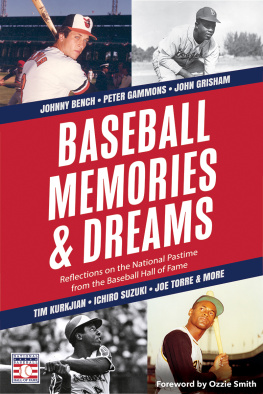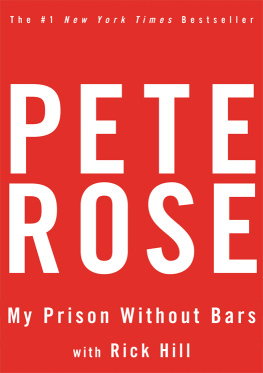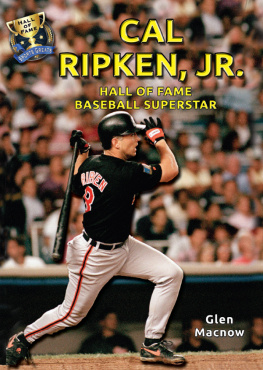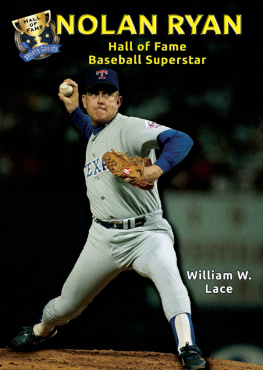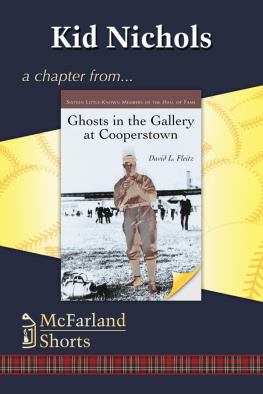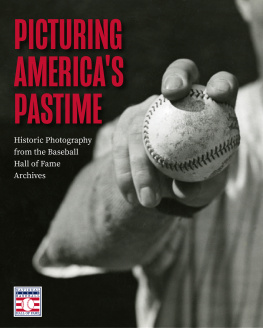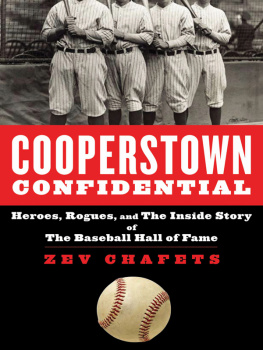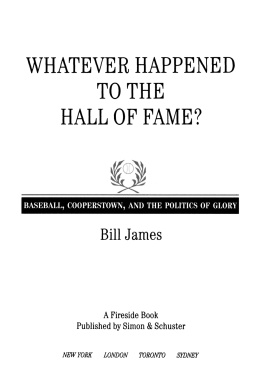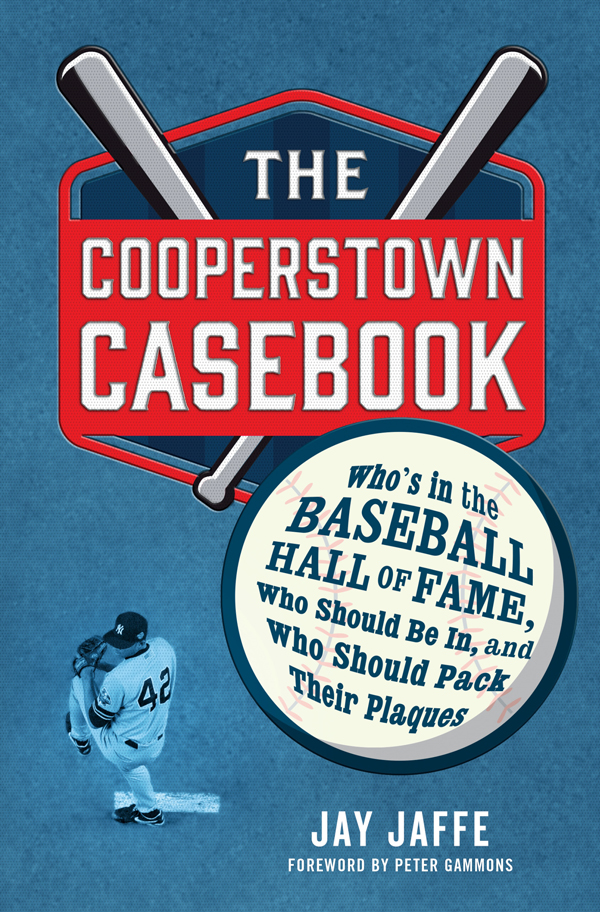Contents
Guide

The author and publisher have provided this e-book to you for your personal use only. You may not make this e-book publicly available in any way. Copyright infringement is against the law. If you believe the copy of this e-book you are reading infringes on the authors copyright, please notify the publisher at: us.macmillanusa.com/piracy.
To Emma and Robin, my inner circle Hall of Famers
The envelope usually arrives in the last week of November, a special annual day. There are names who will never be checked, which is no slight; they all played ten years in the major leagues, a remarkable athletic achievement.
There are names who have been on ballots for anywhere from two years to close to a decade, names that are there for the first time.
But they are names that matter, because the Baseball Hall of Fame in Cooperstown, New York, matters, more than any other sports Hall of Fame or museum. Anyone who doesnt understand should attend the July induction ceremony and try to find his way into the Otesaga Hotel, watch Hall of Famers from Henry Aaron to Ken Griffey, Jr., Phil Niekro to George Brett to Whitey Herzog wandering the lobby or sitting on the porch of the hotel looking out at Lake Otesaga.
I cannot fully express how much it means to be here as a Hall of Famer, Tom Seaver once said. It is the most exclusive club or at least one of the most exclusive clubs in our country. You cannot buy your way in. You cannot be born into it. The Baseball Hall of Fame is all about achievement, about earning your way into membership.
We come back each July to laugh together, eat together, swap stories and rejoice in the reunion with exceptional peers, Johnny Bench said. When Im here, just standing in the hotel lobby reminds me what it means to all of us. If you could sit in on any of our private dinners, you would have access to something that reminds us this is really special.
Sometime between three and five weeks after the ballot arrives in the mail, I return it. I draw up a faux ballot thirty or fifty times, agonize over the tenth and thirteenth names on my drafted list. It is the first sports museum, a national treasure of a museum, and the responsibility for helping decide who is in and who is not, who sits on the porch of the Otesaga and who stays home in Bakersfield sits in the tip of my pen. So when that ballot gets left at the post office some day between Christmas and New Years, it deserves its due diligence and respect.
And as you read The Cooperstown Casebook , understand what Jay Jaffe means to each and every ballot I mail these days. He is, as the preeminent Hall of Fame scholar, my research library, my conscience, my research assistant and ballast.
When I first received ballots, boxes were often checked based on traditional criteria: boldfaced numbers in The Baseball Encyclopedia ; wins, with 300 as an automatic standard; home runs, with 500 as an automatic standard; hits, with 3,000 an automatic qualifier; postseason history.
Several writers seemed to relish in returning blank ballots, as if they were an undercooked meal at Gallaghers. Some based their ballots on personal interactions. Players worthy of serious examination and analysis like Ted Simmons, Luis Tiant, Bobby Grich, and Lou Whitaker slid off of the ballot in a year or two, which today would not happen. In time, as baseball analytics grew and the Hall of Fame election became an emotional and academic study, Bert Blyleven made it on his second-to-last year on the ballot, Jack Morris fell short. In 2016, Tim Raines was elected his last year.
No one weighs all the factors in determining a players place in history better than Jaffe. Many of us understand JAWS as well as we did advanced calculus in the eleventh grade, but then, many of us who have covered and treasured baseball since Carlton Fisk was a rookie are in the eleventh grade in terms of analytics, not graduate school, much less the Sloan School at the Massachusetts Institute of Technology.
We now have defensive, baserunning, catcher framing, and dozens of other metrics. We measure Wins Above Replacement, OPS + , wOBA. Jaffe measures them all, with comparative historic perspective that can let us understand Simmons v. Rick Ferrell, Whitaker v. Nellie Fox, Mike Mussina v. Don Drysdale.
The Cooperstown Casebook takes one from the essentials of the Hall through a course in advanced statistics, positions that have historically been undervalued, the struggle so many of us have lived with weighing the impact and morality of the Steroids Era and its suspicions. He details the work, led by Joe Sheehan, done to examine the credentials of Jack Morris, which leads to the change in the way we vote for MVP and Cy Young Awards; for instance, where once Bob Welch easily won the Cy Young Award because he won 27 games for the Bash Brothers Oakland Athletics, 20 years later campaigns for Zack Greinke and Felix Hernandez were based not on wins but on a combination of analytical evaluations.
This is an evolving process when it comes to Hall of Fame ballots. Mussina presently is a classic example. Many voters and commentators point to his lack of a Cy Young Award, or the fact that he did not win 20 games in a season until his last, while advocates point to the fact that he pitched his entire career in the American League East in the peak of that divisions power, that he made 274 starts in hitter-friendly Camden Yards, Yankee Stadium, and Torontos Skydome, that his player value numbers on Baseball Reference put him in the best 2530 best starters in history, and that taking a closer look at his postseasonsone-hit and 15-strikeout games in which he did not get a decision, as well as two wins over Randy Johnson, all in October 1997put him in a place only a notch or two below Curt Schilling.
Who does and does not make the Hall of Fame matters, whether you are Tom Seaver, Johnny Bench, Henry Aaron, or Joe Morgan, a career voter or a passionate lover of the game or analytical scholar who believes in justice.
No one has examined this justice better than Jaffe. The Cooperstown Casebook will permanently have a place on my essentials desk right through the last week of December when my ballot is mailed, long after the joyous initial reads.
Its easy not to care about the Baseball Hall of Fame. Founded upon a long-debunked myth regarding the sports creation by a future Civil War general in a cow pasture, the museumthe National Baseball Hall of Fame and Museum, to use its full nameis tucked away in central New York, roughly 200 miles from the nearest big league ballpark, Yankee Stadium. You could live your whole life without stumbling upon it.
From its origin in 1936, the Halls selection processes have been arcane, resulting in confusion among voters as well as mistakes in who has been recognized and who has been bypassed. Via the myopia of the Baseball Writers Association of America and the cronyism of the Veterans Committeethe two primary voting bodiesnumerous so-called greats have been inducted despite having not been so great, many of them hailing from the shameful period when baseball excluded black players.
More recently, the process has become cloaked in sanctimony. A sizable faction of writers who failed to recognize and report the infiltration of performance-enhancing drugs into the game has attempted to negate the accomplishments of some of its top players from the last quarter-century, players whose desire to gain a competitive edge by any means wouldnt have been out of place 50 or 100 years ago. Suddenly, these voters are biochemistry experts, able to extrapolate from scant scientific studies the impact of those drugs on player performance, and its connections to the changes the game saw in the 1990s and 2000s.





